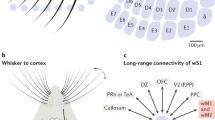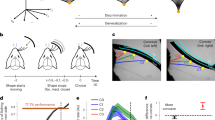Abstract
Rats use their large facial hairs (whiskers) to detect, localize and identify objects in their proximal three-dimensional (3D) space. Here, we focus on recent evidence of how object location is encoded in the neural sensory pathways of the rat whisker system. Behavioral and neuronal observations have recently converged to the point where object location in 3D appears to be encoded by an efficient orthogonal scheme supported by primary sensory-afferents: each primary-afferent can signal object location by a spatial (labeled-line) code for the vertical axis (along whisker arcs), a temporal code for the horizontal axis (along whisker rows), and an intensity code for the radial axis (from the face out). Neuronal evidence shows that (i) the identities of activated sensory neurons convey information about the vertical coordinate of an object, (ii) the timing of their firing, in relation to other reference signals, conveys information about the horizontal object coordinate, and (iii) the intensity of firing conveys information about the radial object coordinate. Such a triple-coding scheme allows for efficient multiplexing of 3D object location information in the activity of single neurons. Also, this scheme provides redundancy since the same information may be represented in the activity of many neurons. These features of orthogonal coding increase accuracy and reliability. We propose that the multiplexed information is conveyed in parallel to different readout circuits, each decoding a specific spatial variable. Such decoding reduces ambiguity, and simplifies the required decoding algorithms, since different readout circuits can be optimized for a particular variable.
Similar content being viewed by others
References
Abeles M (1982) Local cortical circuits: an electrophysiological study. Springer, Berlin
Ahissar E (1998) Temporal-code to rate-code conversion by neuronal phase-locked loops. Neural Comput 10: 597–50
Ahissar E, Kleinfeld D (2003) Closed-loop neuronal computations: focus on vibrissa somatosensation in rat. Cereb Cortex 13: 53–2
Ahissar E, Sosnik R, Bagdasarian K, Haidarliu S (2001) Temporal frequency of whisker movement: II. Laminar organization of cortical representations. J Neurophysiol 86: 354–67
Arabzadeh E, Zorzin E, Diamond ME (2005) Neuronal encoding of texture in the whisker sensory pathway. PLoS Biol 3: e17
Barlow HB (1979) Reconstructing the visual image in space and time. Nature 279: 189–90
Berg RW, Kleinfeld D (2003) Rhythmic whisking by rat: retraction as well as protraction of the vibrissae is under active muscular control. J Neurophysiol 89: 104–17
Bermejo R, Harvey M, Gao P, Zeigler HP (1996) Conditioned whisking in the rat. Somatosens Mot Res 13: 225–33
Bermejo R, Vyas A, Zeigler HP (2002) Topography of rodent whisking-I: two-dimensional monitoring of whisker movements. Somatosens Mot Res 19: 341–46
Brecht M, Grinevich V, Jin TE, Margrie T, Osten P (2006) Cellular mechanisms of motor control in the vibrissal system. Pflugers Arch 453: 269–81
Carvell GE, Simons DJ (1990) Biometric analyses of vibrissal tactile discrimination in the rat. J Neurosci 10: 2638–648
Carvell GE, Simons DJ, Lichtenstein SH, Bryant P (1991) Electromyographic activity of mystacial pad musculature during whisking behavior in the rat. Somatosens Mot Res 8: 159–64
Crochet S, Petersen CC (2006) Correlating whisker behavior with membrane potential in barrel cortex of awake mice. Nat Neurosci 9: 608–10
Derdikman D, Yu C, Haidarliu S, Bagdasarian K, Arieli A, Ahissar E (2006) Layer-specific touch-dependent facilitation and depression in the somatosensory cortex during active whisking. J Neurosci 26: 9538–547
Erchova IA, Lebedev MA, Diamond ME (2002) Somatosensory cortical neuronal population activity across states of anaesthesia. Eur J Neurosci 15: 744–52
Fee MS, Mitra PP, Kleinfeld D (1997) Central versus peripheral determinants of patterned spike activity in rat vibrissa cortex during whisking. J Neurophysiol 78: 1144–149
Fundin BT, Bergman E, Ulfhake B (1997) Alterations in mystacial pad innervation in the aged rat. Exp Brain Res 117: 324–40
Gibson JM, Welker WI (1983a) Quantitative studies of stimulus coding in first-order vibrissa afferents of rats. 2. Adaptation and coding of stimulus parameters. Somatosens Res 1: 95–17
Gibson JM, Welker WI (1983b) Quantitative studies of stimulus coding in first-order vibrissa afferents of rats. 1. Receptive field properties and threshold distributions. Somatosens Res 1: 51–7
Grinevich V, Brecht M, Osten P (2005) Monosynaptic pathway from rat vibrissa motor cortex to facial motor neurons revealed by lentivirus-based axonal tracing. J Neurosci 25: 8250–258
Hopfield JJ (1982) Neural networks and physical systems with emergent selective computational abilities. Proc Natl Acad Sci USA 79: 2554–558
Horev G, Benjamini Y, Sakov A, Golani I (2007) Estimating wall guidance and attraction in mouse free locomotor behavior. Genes Brain Behav 6: 30–1
Jones LM, Depireux DA, Simons DJ, Keller A (2004a) Robust temporal coding in the trigeminal system. Science 304: 1986–989
Jones LM, Lee S, Trageser JC, Simons DJ, Keller A (2004b) Precise temporal responses in whisker trigeminal neurons. J Neurophysiol 92: 665–68
Kleinfeld D, Berg RW, O’Connor SM (1999) Anatomical loops and their electrical dynamics in relation to whisking by rat. Somatosens Mot Res 16: 69–8
Kleinfeld D, Ahissar E, Diamond ME (2006) Active sensation: insights from the rodent vibrissa sensorimotor system. Curr Opin Neurobiol 16: 435–44
Knutsen PM, Derdikman D, Ahissar E (2005) Tracking whisker and head movements in unrestrained behaving rodents. J Neurophysiol 93: 2294–301
Knutsen PM, Pietr M, Ahissar E (2006) Haptic object localization in the vibrissal system: behavior and performance. J Neurosci 26: 8451–464
Krupa DJ, Matell MS, Brisben AJ, Oliveira LM, Nicolelis MA (2001) Behavioral properties of the trigeminal somatosensory system in rats performing whisker-dependent tactile discriminations. J Neurosci 21: 5752–763
Lichtenstein SH, Carvell GE, Simons DJ (1990) Responses of rat trigeminal ganglion neurons to movements of vibrissae in different directions. Somatosens Mot Res 7: 47–5
McKee SP, Welch L, Taylor DG, Bowne SF (1990) Finding the common bond: stereoacuity and the other hyperacuities. Vision Res. 30: 879–91
Mehta SB, Whitmer D, Figueroa R, Williams BA, Kleinfeld D (2007) Active spatial perception in the vibrissa scanning sensorimotor system. PLoS Biol 5: e15
Nguyen QT, Kleinfeld D (2005) Positive feedback in a brainstem tactile sensorimotor loop. Neuron 45: 447–57
Shoykhet M, Doherty D, Simons DJ (2000) Coding of deflection velocity and amplitude by whisker primary afferent neurons: implications for higher level processing. Somatosens Mot Res 17: 171–80
Shuler MG, Krupa DJ, Nicolelis MA (2002) Integration of bilateral whisker stimuli in rats: role of the whisker barrel cortices. Cereb Cortex 12: 86–7
Solomon JH, Hartmann MJ (2006) Biomechanics: robotic whiskers used to sense features. Nature 443: 525
Stuttgen MC, Ruter J, Schwarz C (2006) Two psychophysical channels of whisker deflection in rats align with two neuronal classes of primary afferents. J Neurosci 26: 7933–941
Szwed M, Bagdasarian K, Ahissar E (2003) Encoding of vibrissal active touch. Neuron 40: 621–30
Szwed M, Bagdasarian K, Blumenfeld B, Barak O, Derdikman D, Ahissar E (2006) Responses of trigeminal ganglion neurons to the radial distance of contact during active vibrissal touch. J Neurophysiol 95: 791–02
Vincent S (1912) The Function of the Vibrissae in the Behavior of the White Rat. Behav. Monogr. 1: 7–1
Westheimer G (1981) Visual hyperacuity. Springer-Verlag, Berlin
Whishaw IQ, Kolb R (2005) The behavior of the laboratory rat: a handbook with tests. Oxford University Press, Oxford
Yu C, Derdikman D, Haidarliu S, Ahissar E (2006) Parallel thalamic pathways for whisking and touch signals in the rat. PLoS Biol 4: e124
Zucker E, Welker WI (1969) Coding of somatic sensory input by vibrissae neurons in the rat’s trigeminal ganglion. Brain Res 12: 138–56




